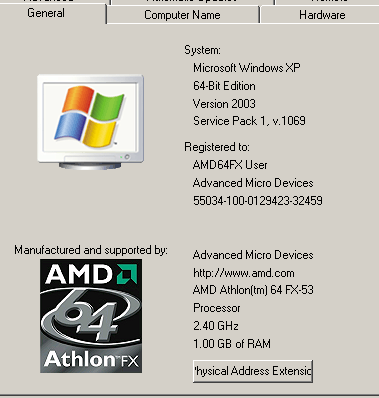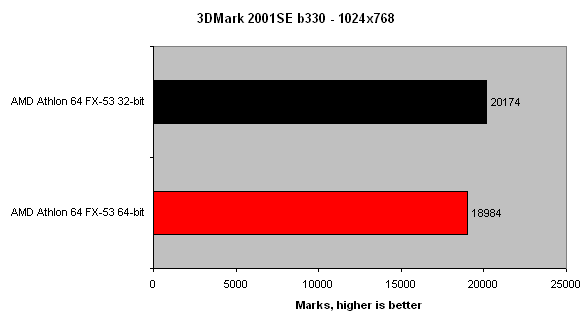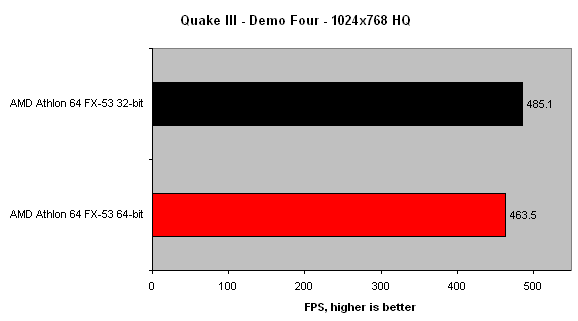A brief 64-bit look
The promiseThe benchmarks, thus far, have covered 32-bit performance, which has been, on the balance of results, at least as good as Intel's finest. AMD's touting the Athlon 64 line as being the best of both worlds, that is, the established 32-bit world which has massive support, both in OS and applications terms, and 64-bit, which is now beginning to become a reality. 64-bit computing needs a compatible CPU (AMD's fine here), a compatible operating system (Windows 64-bit is nearing completion, there's already Linux flavours available), and 64-bit applications that take advantage of the first two conditions.
The first question we have to ask is why is 64-bit computing good. AMD's Athlon 64 FX-53, as well as any AMD CPU that carries the nomenclature of 64, performance increases will come by way of the increased General-Purpose Register (GPR) count and size. The current 32-bit platform can only hold 8 32-bit GPRs (which are small locations on the CPU that hold bits of data and operate at super-fast speeds). Obviously having the ability to hold more is beneficial to performance. AMD's x86-64 ISA widens the GPR to 64 bits (doubling) and adds another 8 64-bit registers on top (doubling again, and integer-only). There's also an additional 8 128-bit (SSE2/XMM) registers present in 64-bit mode. Simplifying it down, if code can best use the increased register space and width, performance should increase. Think of it as AMD's answer to Hyper-Threading; doing more work at a given time.

Just to reiterate, three conditions have to be met before 64-bit performance shows its true colours. A 64-bit-capable CPU (we've got that covered), a 64-bit OS, and applications coded to take advantage of the increased register space. Let's first take a look at how the CPU runs a couple of our usual benchmarks.

We used a NVIDIA GeForce FX5950 Ultra 256MB card for 32- and 64-bit tests. Detonator 53.03 was used for 32-bit Windows XP and Detonator 53.04 for the 64-bit version. Pretty good going, considering that 64-bit windows in running in compatibility mode (Windows on Windows).

Another healthy return from a benchmark that stresses the subsystem. Earlier incarnations of 64-bit Windows XP had horrid drivers and compatibility. That situation's being resolved by each beta 64-bit release.
The reality
I'm purposely not going to benchmark optimised 64-bit software. AMD may supply testers with pre-optimised applications that show terrific performance increases when run in 64-bit mode, but where are they in the general scheme of things?. Trawl the 'net and try to find 64-bit (Windows) software is akin to finding a needle in a haystack. Graphs of RCA encryption and mini-GZIP (file compression) show marked increases, but these are isolated cases. 6 months have passed since the FX-51's release, and we're still far away, seemingly, from having a final Windows XP 64-bit release. I harp on about Windows because it's what most enthusiasts are likely to use. Promise of performance is only good when it will be realised. It's kind of like paper-launching CPUs. You wow at their performance but then find it difficult to obtain and use them. That's how 64-bit software currently is, unfortunately.









